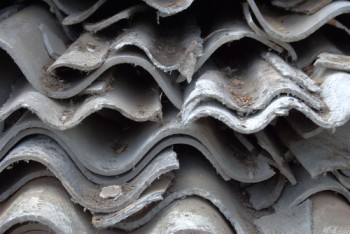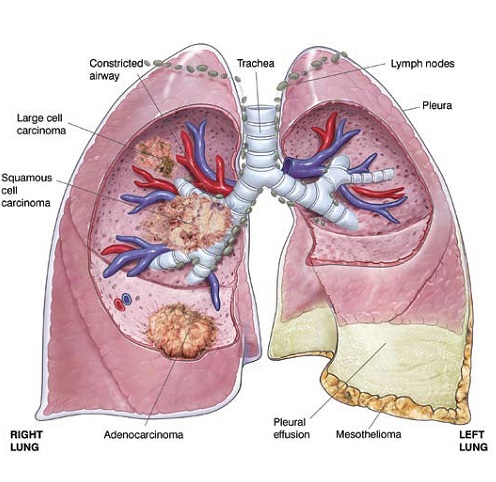 Asbestos, linked directly to mesothelioma, a rare form of lung cancer, is still present in many products used daily in Lebanon. But there’s no protection for workers or the population at large.
Asbestos, linked directly to mesothelioma, a rare form of lung cancer, is still present in many products used daily in Lebanon. But there’s no protection for workers or the population at large.
In 1998, Lebanon submitted to popular pressure and banned asbestos imports. In 2000, Eternit, the country’s major importer of asbestos closed down. But almost no action has been taken to prevent usage of remaining asbestos products or to find substitutes for them.
In the United States, regulations and law firms have been established to protect citizens from asbestos exposure.
But the case for protection people against asbestos in the Middle East is rare.
Consider this:
Sudden environmental disasters such as the recent carpet fire in Safra and protesters burning rubber tires plague the beleaguered country. But asbestos exposure, which leads to mesothelioma, a fatal form of lung cancer specific to asbestos exposure, is an ongoing issue that isn’t being addressed. The worst part is that the dangerous material is still being imported and used.
There are no protected waste dumps for asbestos products in Lebanon. And under an outdated law that permits imports of Crysotile, or “white asbestos,” importers are still bringing in the cancer-linked mineral. The reasoning is that Crysotile is “less dangerous” than other types of asbestos.
In an interview with the Daily Star, Dr. Joseph Kattan doctor of hematology and oncology at Hotel Dieu Hospital, describes all asbestos as dangerous and a direct cause of mesothelioma cancer.
“Unlike various speculations on other types of cancers, there is clear and strong evidence on the cause and effect relationship between asbestos contamination and malignant mesothelioma (a rare cancer directly linked to asbestos exposure),” Kattan said. “If one type of asbestos is less aggressive, it doesn’t mean that it is not dangerous.”
The Eternit offices and warehouses were located in the seaside town of Shekka. When the company closed down, their unsaleable merchandise was simply dumped near a football field. Asbestos-lined irrigation pipes are still lying on the ground. Local people claim that cancer rates are climbing in their town.
But not only is Shekka at high risk to asbestos exposure. Asbestos is still part of air conditioners, brakes, and construction materials, such as the roof tiles below. (For an analysis of Lebanon’s disastrous construction policies, see Linda’s post here.)
 Even the housewife may be exposed to it at home, for ironing board covers are insulated with it.
Even the housewife may be exposed to it at home, for ironing board covers are insulated with it.
Environment Minister Nazim Khoury said that although Lebanon has no waste dumps for asbestos, it is partner in an international agreement whereby all participating countries will help with waste disposal.
“If there are still asbestos products around the country, the owners should file a request to the Environment Ministry to receive help for their disposal,” Khoury said.
Dr. Kattan explained that much of the Lebanese population is still exposed, on daily basis. Car exhaust contains it. And although the Environment Ministry claims that no asbestos-containing products have been imported since 2006, Lebanese companies imported irrigation pipes from Turkey containing asbestos as recently as 2008. It’s a real possibility that tiny asbestos fibers may loosen and flow into the ground with the water and adhere to produce that people eat. Lacking the full-body protection shown in the top photograph, workers exposed to asbestos bring it home on their clothing, exposing their families to it in turn.
According to this PubMed article, continued exposure to asbestos causes asbestosis, a condition where scar tissue (fibrosis) forms inside the lung. Symptoms may include chest pain, cough, shortness of breath with exertion, tightness in the chest, clubbing of fingers, and nail abnormalities. There is no cure for asbestosis, only treatment for symptoms. Asbestosis patients are at high risk of malignant mesothelioma, which can develop 20-40 years after exposure. 75% of patients of mesothelioma die within a year of becoming ill.

It would be interesting to know if anyone in Lebanon, either private individual, township, or business owner, has received help in asbestos waste disposal, and if asbestos-containing products are still coming into the country.
Glimpses of Unpolluted Lebanon on Green Prophet:




Here in Spain the asbestos is banned, but there are thousands of panels on the roofs of buildings, including homes, if the recycling of materials very expensive, so he decides to bury in the ground, but nothing happens, the problem is handled when handled, cut or broken, and the dangerous spores are generated,
Asbestos products are also discarded throughout Israel. Its northern city has one of the highest rates of mesothelioma in the world. You can literally see it everywhere in Tel Aviv. It’s as though people don’t know what it is, or they don’t care.